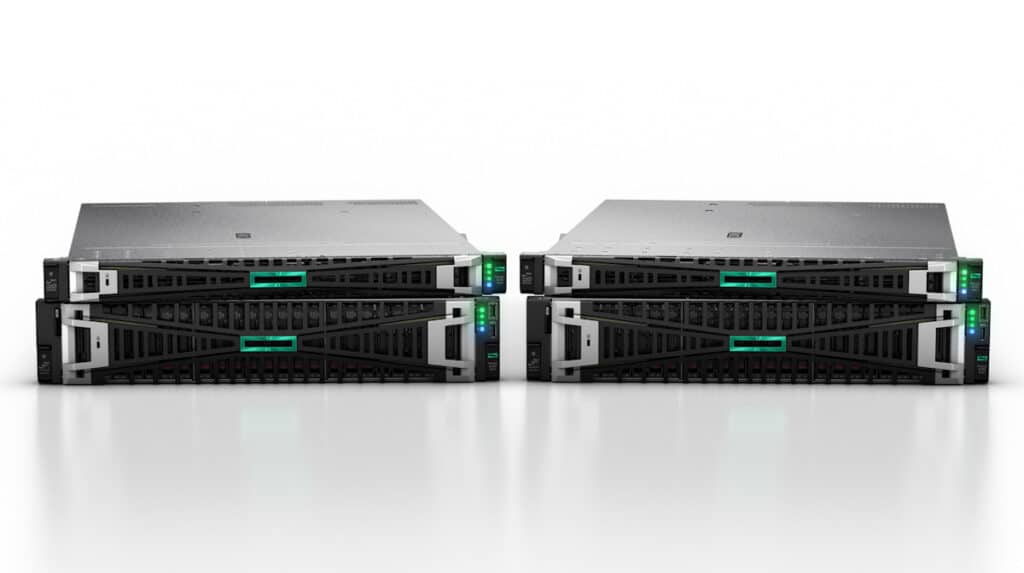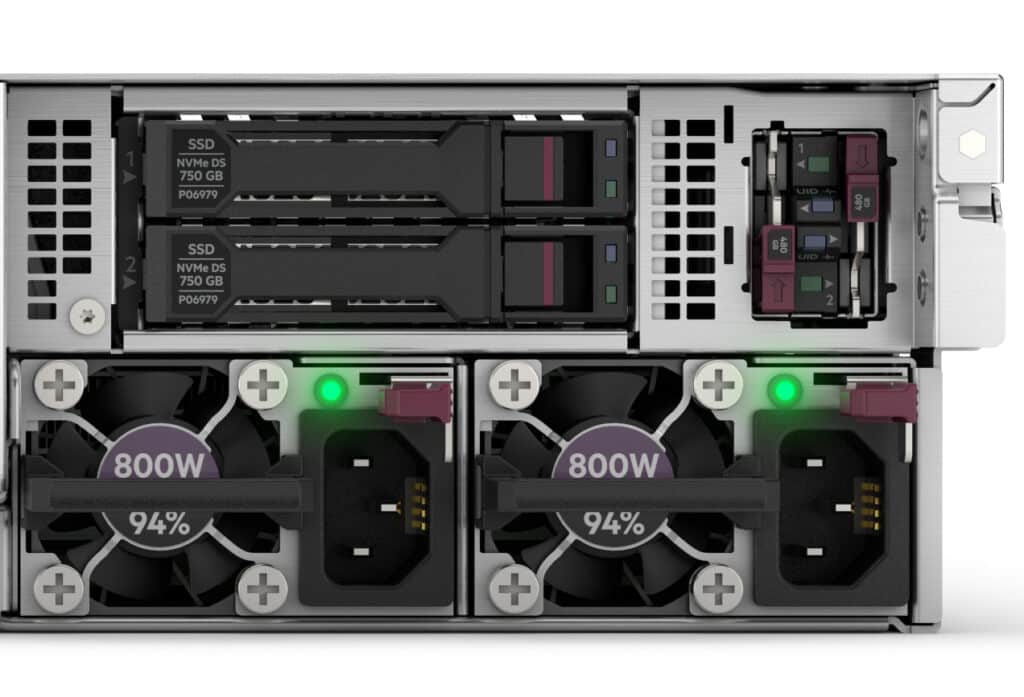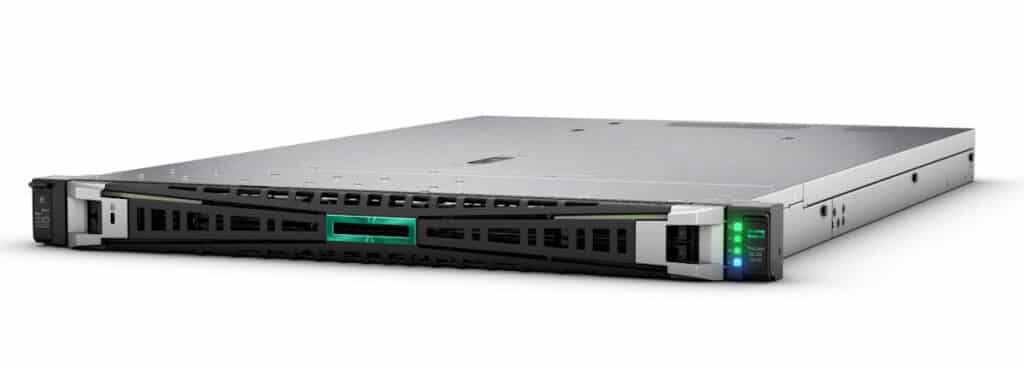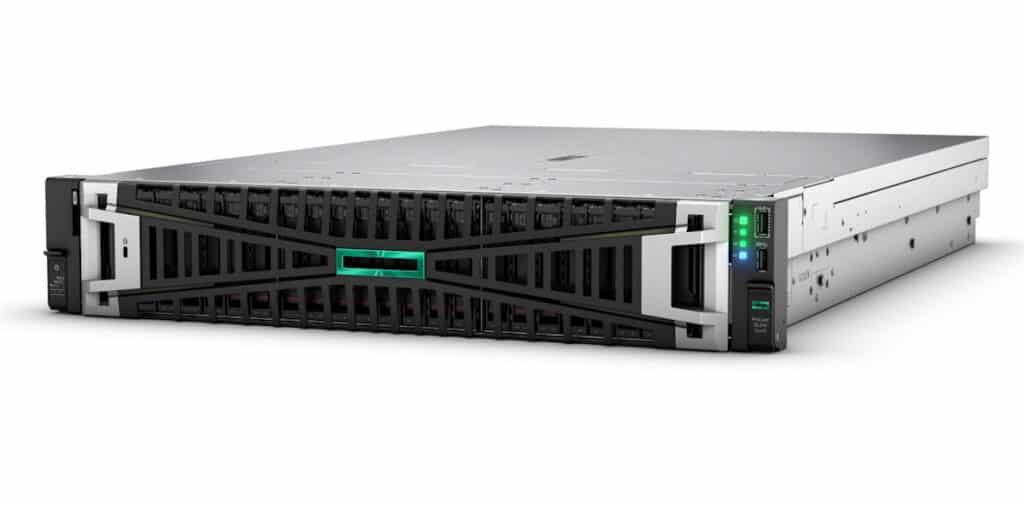HPE introduced a new ProLiant Gen11 server portfolio that delivers a cloud experience designed to power hybrid environments and digital transformation. The next-generation HPE ProLiant servers are designed to provide organizations with intuitive and optimized compute resources ideally suited for various modern workloads, including AI, analytics, cloud-native applications, graphic-intensive applications, ML, VDI, and virtualization. This first set of four servers is based on 4th Gen AMD EPYC known as AMD Genoa.
HPE introduced a new ProLiant Gen11 server portfolio that delivers a cloud experience designed to power hybrid environments and digital transformation. The next-generation HPE ProLiant servers are designed to provide organizations with intuitive and optimized compute resources ideally suited for various modern workloads, including AI, analytics, cloud-native applications, graphic-intensive applications, ML, VDI, and virtualization. This first set of four servers is based on 4th Gen AMD EPYC known as AMD Genoa.

Optimized for GreenLake
The new HPE ProLiant servers include an HPE GreenLake for Compute Ops Management subscription. This cloud-native management console increases operational efficiency by securely automating the process to access, monitor, and manage servers in any location. We posted updates to HPE GreenLake and presented a GreenLake Deep Dive Podcast.
The console provides simple, unified, and automated capabilities so customers can control their compute environment with global visibility and insight. Customers can also quickly onboard thousands of distributed devices and benefit from faster server firmware updates. HPE GreenLake for Compute Ops Management includes carbon footprint reporting to view energy usage and emission metrics from individual servers to full compute environments.
HPE Silicon Root of Trust
HPE continues to deliver a secure infrastructure, from edge to cloud, with HPE Silicon Root of Trust delivering a security capability that protects millions of lines of firmware code, from malware to ransomware, with a digital fingerprint that is unique to the server.
The next-generation HPE ProLiant servers build on the HPE Silicon Root of Trust with new features to protect data and systems, including:
- Ensure verification and authentication for device components with the new version of the HPE Integrated Lights-Out (iLO), with iLO6. ILO is a remote server management software that enables customers to configure, monitor, and update HPE servers seamlessly and securely. The latest version features new authentication using the Security Protocol and Data Model (SPDM), a key security capability in servers for authenticating and securely monitoring devices in an open standards-based approach.
- Prevent alterations to unique server identity access with the inclusion of platform certifications and Secure Device Identity (iDevID) by default.
- Gain an additional layer of authentication by monitoring a secure boot and system state through the Trusted Platform Module (TPM).
- Adopt the highest level of security through the HPE Trusted Supply Chain. The HPE Trusted Supply Chain advances end-to-end security with certified servers that feature hardened data protection during manufacturing. Recently, HPE extended options for certified servers from US-based factories to produce and ship worldwide.
Four HPE Genoa Servers
From a hardware perspective, HPE is essentially debuting two ProLiant servers powered by AMD Genoa. There are single-processor and dual-processor variants in 1U and 2U chassis. Within, there are a few notable updates when compared to the Gen10 servers.
First, customers will now have access to externally accessible RAID NVMe boot drives. This is a big enhancement, prior boot drives were only serviceable by removing the lid. Now, the redundant boot drives can be accessed at the back of the machine for easy replacement. This gets ProLiant even with the Dell BOSS drive and is an important step forward.
The other big step forward in terms of storage is the adoption of E3.S. As you’ll see in the specs below, this gives HPE a massive density advantage when it comes to storage, especially in the 1U chassis where bays are traditionally limited by the 15mm U.2 form factor. In the traditional U.2 design, you’re limited to 10 SSDs. With E3.S, there’s now support for 20 SSDs in the front, doubling up the storage potential.
The 2U chassis offer additional storage via midplane options and even more bays in the rear of the chassis. Overall, these ProLiant Genoa servers should bring a lot of flexibility to the market. That said, the E3.S configurations aren’t immediately available and HPE has not yet provided clarity as to when they’ll be shipping other than the first half of next year. So customers may have to wait a while to get access to the really dense storage configs.
That said, SSD vendors that have gone to E3.S should be doing backflips in anticipation of a major server provider finally shipping these bays. Kioxia and Samsung have been touting E3.S solutions for around a year, just waiting for someone to broadly ship the slot for them to fill.
HPE ProLiant DL325 Gen11 – Cost optimized solution
| FEATURE | SPEC |
| Processors | 1x 4th Generation AMD EPYC processors up to 96 cores |
| Memory | Up to 3TB DDR5, CXL 1.1 supported |
| Front Drive Count | Up to 4 LFF HDD/SSD; SAS/SATA; Up to 10 SFF HDD/SSD; SAS/SATA/NVMe; Up to 20 EDSFF E3.S; NVMe |
| Rear Drive Count | No rear drive support |
| Boot Options | Up to lx internal access SATA/NVMe M.2 or lx External access hot-pluggable raided M.2 NVMe (Note: Will not take up a PCIe slot) |
| GPU Support | Up to 2SW or 2DW* |
| I/O | Up to 2 x16 PCIe Gen5 slots; Up to 2 x8 OCP3.0 slots (upgradable to x16) |
| Storage Controller | GEN11 Controllers (PCIe and OROC) |
| Chassis Depth | SFF: 25.5″; LFF/EDSFF: 27.9″; GPU front end: 32.2″ |
| Targeted Workloads | Software Defined Compute; CDN; low-end VDI |
HPE ProLiant DL345 Gen11 – Single-socket scalable solution
| FEATURE | SPEC |
| Processors | 1x 4th Generation AMD EPYC processors with up to 96 cores |
| Memory | Up to 3TB DDR5, CXL 1.1 supported |
| Front Drive Count | Up to 12 LFF HDD/SSD; SAS/SATA; Up to 24 SFF HDD/SSD; SAS/SATA/NVMe; Up to 36 EDSFF E3.S; NVMe |
| Mid Tray Count | Up to 8 SFF SAS/SATA/NVMe OR Up to 4 LFF SAS/SATA |
| Rear Drive Count | Up to 2 SFF SAS/SATA/NVMe OR Up to 4 LFF SS/SATA |
| Boot Options | 1x External access hot-pluggable raided M.2 NVMe (Note: Will not take up a PCIe slot) |
| GPU Support | Up to 4SW or 2DW |
| I/O | Up to 6 x16 PCIe Gen5 slots; Up to 2 x8 OCP3.0 slots (upgradable to x16) |
| Storage Controller | GEN11 Controllers (PCIe and OROC) |
| Chassis Depth | SFF/EDSFF: 25.4″; LFF: 26.1″; GPU front end: 31.4″ |
| Targeted Workloads | Software Defined Compute; CDN; low-end VDI |
HPE ProLiant DL365 Gen11 – Rack optimized dense solution
| FEATURE | SPEC |
| Processors | 2x 4th Generation AMD EPYC processors with up to 96 cores |
| Memory | Up to 6TB DDR5, CXL 1.1 supported |
| Front Drive Count | Up to 10 SFF HDD/SSD; SAS/SATA/NVMe; Up to 20 EDSFF E3.S |
| Rear Drive Count | No Rear Drive |
| Boot Options | 1x External access hot-pluggable raided M.2 NVMe (Note: Will not take up a PCIe slot) |
| GPU Support | Up to 2SW or 2DW |
| I/O | Up to 2 x16 PCIe Gen5 slots; Up to 2 x8 OCP3.0 slots (upgradable to x16) |
| Storage Controller | GEN11 Controllers (PCIe and OROC) |
| Chassis Depth | SFF: 25.6″; GPU: -32.2″ |
| Targeted Workloads | Software Defined Compute; CDN; low-end VDI |
HPE ProLiant DL385 Gen11 – Accelerator optimized solution
| FEATURE | SPEC |
| Processors | 2x 4th Generation AMD EPYC processors with up to 96 cores |
| Memory | Up to 6TB DDR5, CXL 1.1 supported |
| Front Drive Count | Up to 12 LFF HDD/SSD; SAS/SATA; Up to 24 SFF HDD/SSD; SAS/SATA/NVMe; Up to 36 EDSFF E3.S Up to 48 SFF HDD/SDD (Post Launch) |
| Mid Tray Count | Up to 8 SFF SAS/SATA/NVMe OR Up to 4 LFF SAS/SATA |
| Rear Drive Count | Up to 8 SFF SAS/SATA/NVMe OR Up to 4 LFF SS/SATA |
| Boot Options | 1x External access hot-pluggable raided M.2 NVMe (Note: Will not take up a PCIe slot) |
| GPU Support | Up to 8SW or 4DW |
| I/O | Up to 8 PCIe Gen5 slots; Up to 2 x8 OCP3.0 slots (upgradable to x16) |
| Storage Controller | GEN11 Controllers (PCIe and OROC) |
| Chassis Depth | SFF/EDSFF: 25.4″; LFF: 26.1″; GPU front end: 31.4″ |
| Targeted Workloads | Software Defined Compute; CDN; low-end VDI |
New services to expand the customer experience.
HPE unveiled enhancements to its customer experience, supporting HPE ProLiant Gen11 servers, including:
- HPE Pointnext Complete Care Secure Locations offers customers assigned experts to deliver support to locations where access, connectivity, as well as electronic and verbal communications are subject to specific security measures.
- HPE Expert on Demand provides customers with access to services professionals with dedicated expertise related to HPE’s next-generation compute offerings.
- HPE Support Center, which provides online services and a support platform, has been enhanced to include greater collaboration, case management, enhanced virtual agent troubleshooting, and a new digital insights dashboard.
- Support for HPE’s next-generation compute has been extended from three to five years to up to seven years.
Availability
HPE ProLiant Gen11 servers featuring 4th Generation AMD EPYC processors will be available to order worldwide starting on November 10 including through the HPE GreenLake cloud platform. HPE has not yet announced support for their SDS and HCI offerings for these servers, but that’s expected in the coming months.
Engage with StorageReview
Newsletter | YouTube | Podcast iTunes/Spotify | Instagram | Twitter | TikTok | RSS Feed




